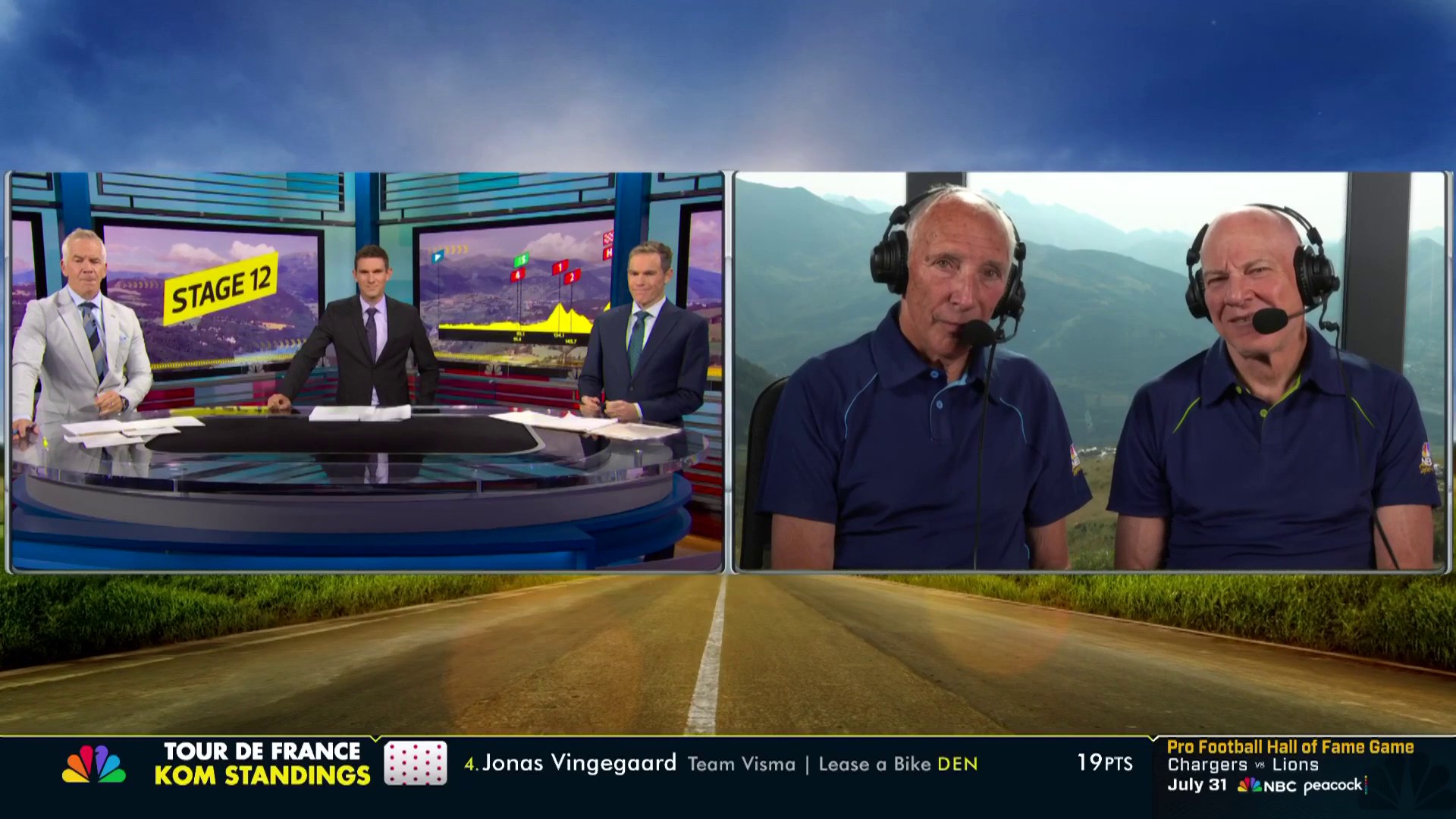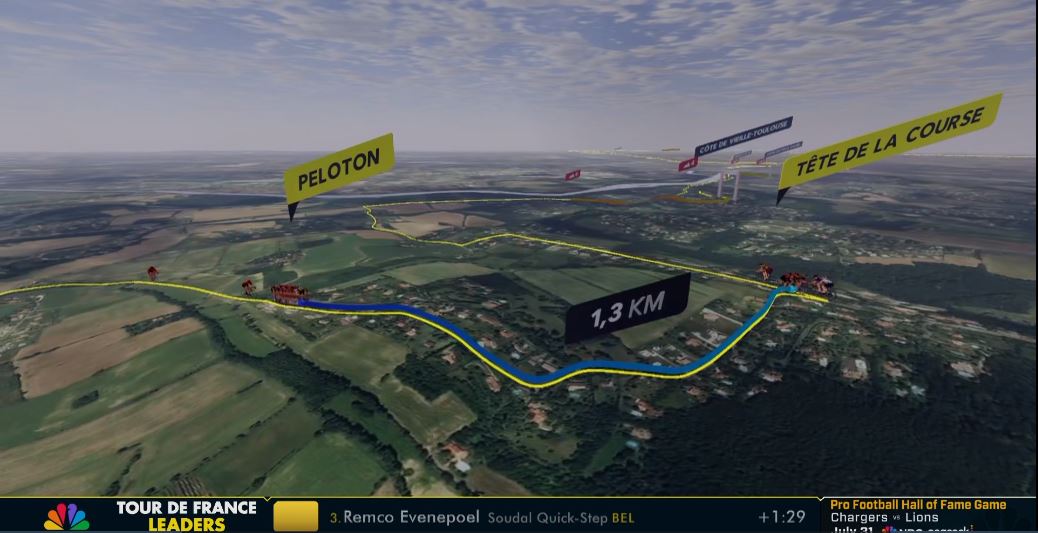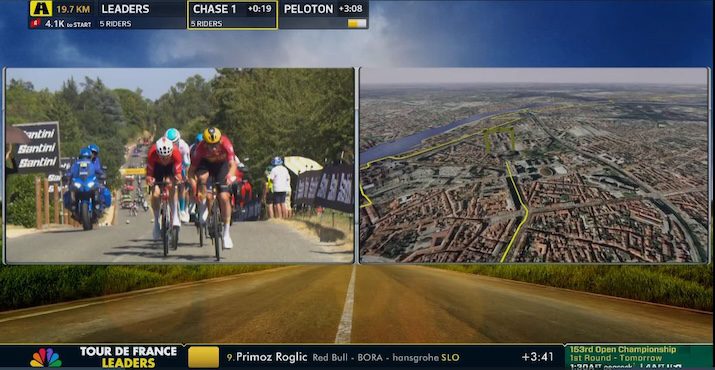The broadcaster upgrades transmission tech, deploys hybrid production and compelling graphics
By Mark J Burns, SVG Contributor
Wednesday, July 23, 2025 – 11:36 am
The Tour de France, which finishes Sunday with the final stage on the Champs-Élysées in Paris, is “one of the most logistically complex sporting events in the world,” says NBC Sports Coordinating Producer Joel Felicio. Produced by Felicio and his team, NBC Sports’ coverage of the 2025 cycling competition uses high-speed internet transmission, a hybrid production model, and visual graphics to inform both die-hard fans and casual viewers.
“The Tour is unlike any other sporting event — and the production reflects that,” he says. “The entire TV compound moves to a new location every single day, often two, three or even five hours apart from the previous stage. That means everything has to be set up, broken down, packed up, and transported, all within a tight overnight window. Unlike traditional sports, where you might get one or two setup days in a fixed venue, the Tour gives you no margin for error.
“To make it even more challenging,” he continues, “we’re not building in standard broadcast locations. These TV compounds are being constructed in the middle of busy cities one day and on top of giant mountains the next. Narrow roads, tight spaces, unpredictable weather — it all comes with the territory. The fact that this operation runs smoothly day after day is honestly remarkable and a real testament to the precision, creativity, and dedication of everyone involved.”
This year, the biggest change in the way NBC/Peacock covers the Tour is on the transmission side. Previously, the broadcaster relied on a satellite truck at the finish line to send feeds to the control room in Stamford, CT. However, that setup was limited to four transmission paths at a time. Says Felicio, “It was expensive and complex and constrained how much content we could work with in real time.”
This year, NBC/Peacock moved to using Orange-supplied high-speed internet at the finish line and shifted to an IP-based workflow. The transition is “a major technical leap forward,” he says. “We now have access to 12 iso feeds coming back live to Stamford every day, including motos, helicopters, studio cameras, roving reporters, and more. It gives us much greater flexibility in production and dramatically expands what we can show and how we tell the story of each stage.”
Featuring a mostly remote setup, the production model is a hybrid: with a lean production crew at the finish line, the Tour de France show is fully produced from a control room in Stamford, where all camera feeds are sent in real time.
‘Technology Should Serve the Story’
NBC Sports leans heavily on technology for the broadcast of the 21-day race, Felicio says, noting the use of LiveU technology in deploying roaming reporter Christian Vande Velde as a particular example. Steve Porino is also onsite as a field reporter.

Vande Velde begins each stage at the stage’s start line, provides live commentary from the road, and interviews racers at the stage finish. His vehicle is outfitted with Starlink to provide a mobile, high-bandwidth connection.
“It remains one of our most valuable storytelling tools,” says Felicio of Vande Velde’s reporting live from a moto inside the race. “Christian gives us a view of the race that cameras alone can’t always capture — everything from road conditions and weather to team tactics unfolding within the peloton. As a former pro rider, he brings a sharp understanding of the race dynamics, and, when he’s descending a mountain at 60 miles per hour just to stay with the leaders, it helps viewers feel the intensity of the moment.”
The broadcast also uses a 3D mapping system with live GPS data to track rider positions and to show time gaps, terrain, and wind, Felicio says, to “better illustrate race dynamics in real time.
“Our philosophy is that technology should serve the story,” he continues. “It allows us to be nimble in the field, smart in the studio, and constantly evolving how we bring the most dynamic race in sports to our audience.”
Additionally, the NBC Sports studio features an augmented-reality environment, the “sandbox,” which helps the cycling broadcast talent — host Paul Burmeister and analysts Brent Bookwalter and Tejay van Garderen — to analyze team strategy, race tactics, and peloton dynamics. The effort is spearheaded by Prometheus.
“We can depict everything from rider positioning to team cars, soigneurs, and even the moto cameras themselves,” says Felicio, “helping viewers understand the complexity of the race in a fresh, modern way.”

The operation strives to seamlessly integrate the onsite team with the studio show, including regular check-ins with play-by-play announcer Phil Liggett, covering his 53rd Tour de France, and analyst Bob Roll from a stage’s finish line. Roll typically rides the final parts of each stage ahead of the racers to highlight important sections and hazards for the audience. “By weaving in live scenes and insight from France,” Felicio says, “we aim to create a broadcast that feels connected and cohesive, no matter where it’s being produced.”
Emphasis on On-Screen Data, Visually Compelling Graphics
The production team aims to provide the on-screen data and graphics to inform the audience without taking up too much real estate to do so. “We know the Tour de France is one of the most visually stunning sporting events in the world,” Felicio says, “and we never want our graphics to get in the way of that experience. Every graphic we use is designed with that balance in mind.”
The top of the broadcast screen — which NBC refers to as “the hat” — highlights essential data: stage information, time gaps, race status. The bottom of the screen is designed for a scrolling ticker providing race updates. Rider information and accompanying graphics are triggered contextually when a particular participant appears on screen. The lower third is typically used for course profiles, rider statistics, and group time gaps — without obstructing the view of the race. All live-data graphics are handled by SMT.
“Ultimately,” Felicio says, “our approach is to enhance the storytelling and understanding of the race, not to compete with the imagery. We design every element to be clean, purposeful, and additive to the viewing experience.”

One of the most compelling broadcast features for the Tour de France is the access to near real-time team-radio audio, which helps viewers understand tactics, road conditions, and overall strategy between riders and team directors. “Sometimes it’s intense, sometimes emotional, and sometimes it’s just fascinating to hear how decisions are made under pressure,” Felicio says. “It’s an incredible window into the inner workings of the race that fans rarely get to experience.”
Another Tour broadcast feature he’s excited about is the ability to show live speeds of different groups. “The cameras don’t always do it justice,” he notes. “Riders can appear to be soft-pedaling, but then you see the speed graphic and realize they’re going 35 mph. That’s astonishingly fast. Being able to display that in real time gives viewers a much deeper appreciation for the athleticism and intensity involved.”
In this year’s edition of the Tour de France, NBC Sports introduced new biometric data through a partnership with human-performance company WHOOP. For certain riders, the broadcast displays different metrics — heart rate, calories burned, sleep score, recovery status, stress level — offering viewers a more in-depth look at what the athletes experience throughout competition.
One of the biggest goals of NBC Sports’ coverage is to “make the Tour de France approachable for everyone,” Felicio says, adding, “Whether someone is a die-hard fan tuning in for the strategy, tactics, and tech or a first-time viewer stumbling across stunning aerial shots of the French countryside, we want them to feel welcome and engaged.”
Given the unique nature of cycling where there aren’t necessarily local teams, Felicio and his team “work hard to build compelling characters” in the event’s riders. “Our job,” he says, “is to bring those human stories to life and help fans feel emotionally invested no matter their level of cycling knowledge.”
